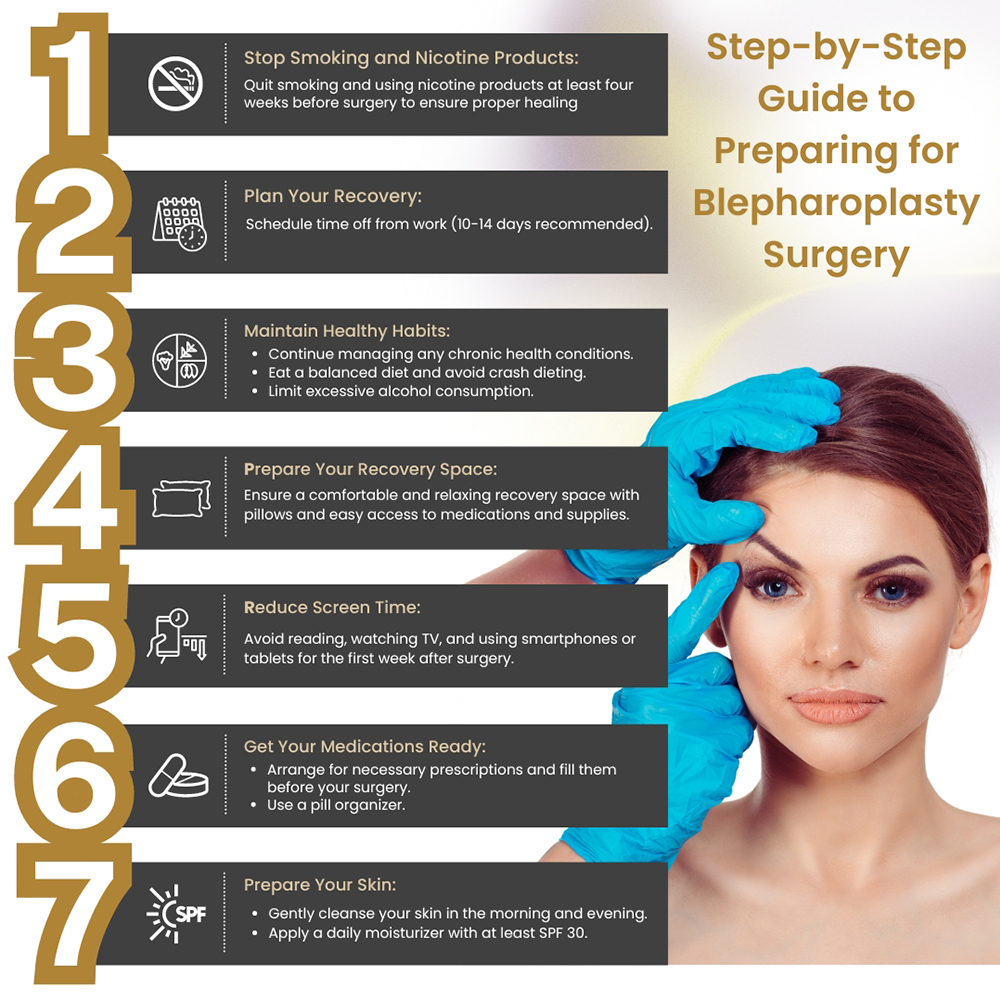What’s Different about Blepharoplasty Preparations?
Your eyelid surgery may be performed for medical reasons — like droopy eyelid surgery that addresses vision issues — or for cosmetic reasons — such as eyelid lift surgery to rejuvenate your appearance. The preparations for these blepharoplasty procedures are the same as for all cosmetic surgeries, but since your eyes and the surrounding skin are so tender, you need to follow somewhat stricter instructions to prepare.
No matter why you’re choosing to get eyelid surgery, there are certain measures you need to take to prepare for the procedure and the recovery process.
A starting process includes:
- Assessing your vision with an eye examination
- Evaluating your tear production
- Measuring your eyelids
- Taking photographs of your eyes
While any surgical procedure can be a bit stressful, Dr. David Shokrian at Millennial Plastic Surgery in New York City provides you with helpful information during every step of the process so you know what to expect. You may also want to discuss complementary procedures during your preparatory consultation.
These may include a:
- Brow lift
- Face lift
- Mini-facelift
How Can I Best Prepare for Blepharoplasty Surgery?
Before your blepharoplasty surgery, your NYC doctor gives you a checklist of tasks to do and things not to do before the surgery. This guide is tailored for you so that you make the best of your surgery and there are no problems in the recovery process.
Prior to your procedure, you’re advised to:
- Take care of your skin by gently cleansing in the morning and evening, applying a daily moisturizer of at least SPF 30.
- Schedule time off from work after the surgery. You may want to wait 10 to 14 days before returning to work.
- Make sure someone drives you to and from your appointment and stays with you for at least 24 hours after surgery.
- Stop smoking and using any nicotine products at least four weeks before surgery.
- Stay healthy in the weeks leading up to surgery, maintaining your treatment of any chronic health conditions.
- Eat a balanced diet and avoid crash dieting. Don’t drink an excessive amount of alcohol before your surgery.
Before your surgery date, make sure you plan on ways that can keep you entertained and occupied while you’re resting your eyes during the recovery phase. Reduce the amount of screen time you partake in and find some good soothing music and audiobooks, your favorite podcasts or just talking with friends and family. Have everything ready for when you return home so you won’t have to get it all together while you’re healing and trying to rest.
How Do I Prepare for the Different Types of Blepharoplasties?
Blepharoplasty removes fat and skin from your eyelids so you have a more youthful and defined look. Eyelid surgery in NYC can also be used to treat common eye conditions, such as ptosis and ptosis amblyopia, which are caused by drooping eyelids.
Your preparation includes understanding the difference between the surgical options available, such as:
- Upper eyelid surgery is mostly used to remove excess skin fat and fix droopy eyelids. If your eyes are dry and the upper eye lids interfere with your peripheral vision, an upper blepharoplasty eliminates these issues. The incisions are easily hidden too, something that concerns both women and men preparing for the procedure.
- Lower eye blepharoplasty is primarily a cosmetic surgery done to reduce puffiness under your eyes and remove or reduce bags. During this procedure, your eye surgeon makes a very small cut either below your eye lashes or inside the lower lid to remove the fat.
Whether you get one surgery done at a time or combine them for a double eyelid surgery, preparatory factors you must consider include:
- Blepharoplasty cost. Insurance may cover upper eyelid surgery if it impairs vision; otherwise, it’s considered a cosmetic procedure and not usually covered.
- Time difference. It usually takes 45 to 60 minutes for upper eyelid surgery, about 90 minutes for lower eyelid surgery, and up to three hours for a combined procedure.
- Surgery difference. While your preparation routine remains the same for both types of blepharoplasties, the incision locations differ, based on your chosen procedure.

What Post-Surgery Measures Should I Take?
After you’re done with the procedure, arrange to have someone with you for at least the next 48 hours. Don’t miss any medications that you’ve been prescribed and make sure you apply cold compresses frequently because it helps with the swelling and bruising. In the first few days, give your eyes as much rest as possible, while sleeping with your head elevated. Avoid any type of intense activities like heavy lifting or aerobic exertion until your doctor gives you the go-ahead.
Prepare your home so you can take further measures, such as:
- Avoiding scheduling important events in first couple weeks after the surgery
- Arranging for someone to take care of your responsibilities like pet care, childcare or housecleaning
- Notifying family to adjust social commitments
- Setting up a personal area that’s quiet and comfortable
- Using extra pillows
- Creating low lighting in the space
Consider consulting with a professional dietician to eat healthier, as your diet should be high in proteins like fish, eggs, meat and legumes, which help repair body tissues. Eat as many fruits and vegetables as you can for their vitamins and antioxidants. Drink more than you normally would, as remaining hydrated is key to a healthy recovery. Stay away from salty foods because they cause bloating and inflammation. Avoid alcohol and coffee.
Attend all the scheduled follow-up appointments with your doctor so that you’re informed about the healing process. Contact Dr. Shokrian at Millennial Plastic Surgery for a free consultation to find out if you’re a good candidate for blepharoplasty. Then you can start preparing for a more youthful-looking you.
